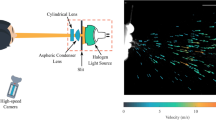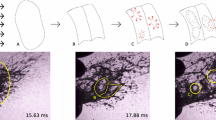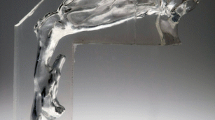Abstract
In an attempt to obtain a deeper understanding of the factors which determine the characteristics of expirated bloodstain patterns, the mechanism of formation of airborne droplets was studied. Hot wire anemometry measured air velocity, 25 mm from the lips, for 31 individuals spitting, coughing and blowing. Expirated stains were produced by the same mechanisms performed by one individual with different volumes of a synthetic blood substitute in their mouth. The atomization of the liquid at the lips was captured with high-speed video, and the resulting stain patterns were captured on paper targets. Peak air velocities varied for blowing (6 to 64 m/s), spitting (1 to 64 m/s) and coughing (1 to 47 m/s), with mean values of 12 m/s (blowing), 7 m/s (spitting) and 4 m/s (coughing). There was a large (55–65%) variation between individuals in air velocity produced, as well as variation between trials for a single individual (25–35%). Spitting and blowing involved similar lip shapes. Blowing had a longer duration of airflow, though it is not the duration but the peak velocity at the beginning of the air motion which appears to control the atomization of blood in the mouth and thus stain formation. Spitting could project quantities of drops at least 1600 mm. Coughing had a shorter range of near 500 mm, with a few droplets travelling further. All mechanisms could spread drops over an angle >45°. Spitting was the most effective for projecting drops of blood from the mouth, due to its combination of chest motion and mouth shape producing strong air velocities. No unique method was found of inferring the physical action (spitting, coughing or blowing) from characteristics of the pattern, except possibly distance travelled. Diameter range in expirated bloodstains varied from very small (<1 mm) in a dense formation to several millimetres. No unique method was found of discriminating expirated patterns from gunshot or impact patterns on stain shape alone. Only 20% of the expirated patterns produced in this study contained identifiable bubble rings or beaded stains.














Similar content being viewed by others
References
State, vs. Peterson (2013) Court of Appeals of North Carolina, No. COA12–1047
Scientific Working Group on Bloodstain Pattern Analysis (SWGSTAIN) (2009) Scientific Working Group on Bloodstain Pattern Analysis: Recommended Terminology. Forensic Science Communications 11(2). The Federal Bureau of Investigation Laboratory Division. https://archives.fbi.gov/archives/about-us/lab/forensic-science-communications/fsc/april2009/standards/2009_04_standards01.htm. Accessed 15 Nov 2016
Donaldson AE, Taylor MC, Cordiner SJ, Lamont IL (2010) Using oral microbial DNA analysis to identify expirated bloodspatter. Int J Legal Med 124(6):569–576
Emes A (2001) Expirated blood: a review. J Can Soc Forensic Sci 34(4):197–203
Donaldson AE, Walker NK, Lamont IL, Cordiner SJ, Taylor MC (2011) Characterising the dynamics of expirated bloodstain pattern formation using high-speed digital video imaging. Int J Legal Med 125(6):757–762. doi:10.1007/s00414-010-0498-5
Chao CYH, Wan MP, Morawska L, Johnson GR, Ristovski ZD, Hargreaves M, Mengersen K, Corbett S, Li Y, Xie X, Katoshevski D (2009) Characterization of expiration air jets and droplet size distributions immediately at the mouth opening. J Aerosol Sci 40(2):122–133. doi:10.1016/j.jaerosci.2008.10.003
Yang S, Lee GWM, Chen C-M, Wu C-C, Yu K-P (2007) The size and concentration of droplets generated by coughing in human subjects. Journal of Aerosol Medicine 20(4):484–494. doi:10.1089/jam.2007.0610
Denison D, Porter A, Mills M, Schroter RC (2011) Forensic implications of respiratory derived blood spatter distributions. Forensic Sci Int 204(1–3):144–155. doi:10.1016/j.forsciint.2010.05.017
Carter GS (1996) A consideration of coughed and spat-out blood. Forensic Science Service Report No TN 817, August 1996
Geoghegan PH, Spence CJT, Wilhelm J, Kabaliuk N, Taylor MC, Jermy MC (2016) Experimental and computational investigation of the trajectories of blood drops ejected from the nose. Int J Legal Med 130(2):563–568. doi:10.1007/s00414-015-1163-9
Geoghegan PH, Spence CJT, Kabaliuk N, Wilhelm J, Aplin J, Taylor MC, Jermy MC (2014) The flow field external to the human nose and the acceleration of blood drops from the nasal cavity during violent assault. In: 17th International Symposium of Laser Techniques to Fluid Mechanics, Lisbon, Portugal, 7th–10th July. http://ltces.dem.ist.utl.pt/lxlaser/lxlaser2014/finalworks2014/papers/03.15_1_108paper.pdf. Accessed 15 Nov 2016
Bond NI (2008) Validation of assumptions underlying the angle of impact calculation for a bloodstain and the development of a synthetic blood substitute. Dissertation, University of Auckland, Auckland, New Zealand
Acknowledgements
We would like to thank Margaret Dodds for her patient help with the experimental set-up and obtaining materials.
Author information
Authors and Affiliations
Corresponding author
Rights and permissions
About this article
Cite this article
Geoghegan, P., Laffra, A., Hoogendorp, N. et al. Experimental measurement of breath exit velocity and expirated bloodstain patterns produced under different exhalation mechanisms. Int J Legal Med 131, 1193–1201 (2017). https://doi.org/10.1007/s00414-017-1545-2
Received:
Accepted:
Published:
Issue Date:
DOI: https://doi.org/10.1007/s00414-017-1545-2




